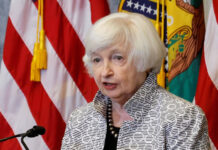Since the election of Donald Trump to the White House and up to the mid-term elections this past Tuesday, the turbulent relationships between the president and the american media have transformed political life in a chronic jerky and irregular, made up of the tweets and editorials as vehement as it is unpredictable. The reverse of this movement, Donald Trump knows a flat calm for more than 600 days in the field surveys. Not the slightest wave hits the popularity rating of the u.s. president.
” READ ALSO – Midterms: America at a time of choice
With a constancy in any event, it displays an approval rating between 37 and 43% and a rate of unpopularity between 51 and 57%, if we judge by the data of the website Five Thirty Eight, which aggregates the results of all surveys. Variations low, because it is necessary to take into account the margin of error that can reach three points. Le Figaro made the point about these data and what this may mean for the “Midterms”.
● Donald Trump keeps his faithful, such as his unfaithful
day after Day, the dots connected between them form two lines almost horizontal, his popularity and that of his unpopularity: every slight rise is always followed by a slight decrease, and vice versa.
In this context, it is difficult to see the emergence of dynamic in the favor or the disfavor of the american president. By refining the reading, we see emerge a very slight trend of improvement since last December, after a first year marked by a slight decrease, but the slope of the curve is low.
what does this constancy in the popularity and the unpopularity of Donald Trump is it the name? “The United States are completely polarized. The two companies confront each other, separated by a ravine, analysis Jean-Eric Branaa, a lecturer at the Université Panthéon-Assas. Trump encourages this polarization to trigger the wrath of the democrats. Its voters have the impression that this wrath is directed against them. They can then say that the democrats are not democrats, but they impose instead a single thought. Donald Trump boosts non-stop to its base, it is an election campaign ongoing”.
the reaction of The democrats themselves, more viscerally opposed to the american president, and maintains this polarization. “We must not forget the role of the other camp. It is a race very dangerous because it has the only engine that the rejection of Trump. If the democrats win, it reversed course in the system, but without the change. It suggests a campaign ugly by the year 2020”, feared by the author of Trumpland: portrait of an America divided (ed Privat).
● A curve of popularity very different from that of other american presidents
another feature of this constancy of Donald Trump is that she is an exception in recent american history.
“The other presidents enjoyed a state of grace and then fell in the polls, which is not the case of Trump. I often hear people say that it will collapse. In this case, it’s been two years that he collapses in the remaining stable,” quipped Lauric Henneton, a lecturer at the University of Versailles-Saint-Quentin-en-Yvelines and author of The End of the american dream (ed Odile Jacob). Barack Obama (2008 until 2016) is an illustration of this trend, with a popularity that apart from very high (68%) and lower then non-stop for two years until its first elections of the “Midterms” in 2010 where it reached approximately 45%, which is only a few points more than Donald Trump today. Some events may, however, change these underlying trends. Thus, Bill Clinton (1993-2001) has abruptly dropped below 40% during his first year in office with the Monica Lewinsky affair. Conversely, George W. Bush (2001-2008) has jumped after the September 11, 2001, going in a few days from 52% to 86%.
“The goal of Trump was that strength to be stable, its popularity would be crossing that of the other presidents at the time of the ‘Midterms’. The objective is almost completed”, decrypts his side Jean-Eric Branaa, who adds: “The big difference is the level of commitment of its electoral base. Such support never existed in the political history of the american. There was much enthusiasm economic under Bill Clinton, of patriotism under George W. Bush and the hope of a post-racial Obama, but at this point, never seen that before”.
● What is the link between this popularity and the “Midterms” this year, or even the election of 2020?
in return for the unwavering support of his base, his consistency in the polls is not necessarily a rosy future in terms of popularity. While some presidents had known of a lift in public opinion (such as Bill Clinton or Ronald Reagan) after strong declines, there is no evidence at present that Donald Trump will be a remontada enable him to see the number of satisfied exceed that of dissatisfied. Conversely, it is not to anticipate a precipitous drop in the polls. Because two contrary effects can play.
making the “Midterms’ a referendum on his own person, Donald Trump can hope to limit the damage during the elections of the two chambers of the u.s. Congress. All 435 seats of representatives shall be renewed, only one-third of the positions of the senators. “Historically, during their first term in office, american presidents are punished for ‘Midterms’, except George W. Bush carried by a national unity after September 11. In 1994 and in 2010, Bill Clinton and Barack Obama have experienced a cohabitation, which does not stop them from being re-elected two years later. But today, if the democrats would take the house of representatives, Donald Trump can hope to retain the Senate, analysis of Lauric Henneton. We may therefore consider the paralysis of the Congress with the two chambers opposite. It can prejudice the chances of the democrats for 2020 [presidential election] if they give the image of an obstruction that is harmful to the country. Trump could then play the card of the people against the elites that are blocking the country.”
On the other hand, continuing its strategy of polarization of public opinion, Donald Trump takes the risk of depriving the electorate as a moderate, he votes republican, democrat or consider themselves as independent of the two major parties. “For the last line right before the ‘Midterms’, Donald Trump has chosen to highlight the issue of migration rather than its economic results that are good, at least in appearance. Il prefer to choose topics and polarized. However, the voters already mobilized do not need to be remobilized. In contrast, for the small core of undecided, it is not certain that this kind of subjects cause them to switch to republicans. Strategists republicans have, on the contrary, fear of a boomerang effect: that these undecided voters now spend the next democratic rejection of Trump, and then tomorrow for good. This would then be a form of electoral suicide,” says Lauric Henneton. “A lot of Americans define themselves as politically independent. If we take the next binary trumpisme/anti-trumpisme, it does not take into account the reality on the ground is much more complex,” concludes Jean-Eric Branaa.
Understanding of the mid-term elections in the United States – Look on Figaro Live















